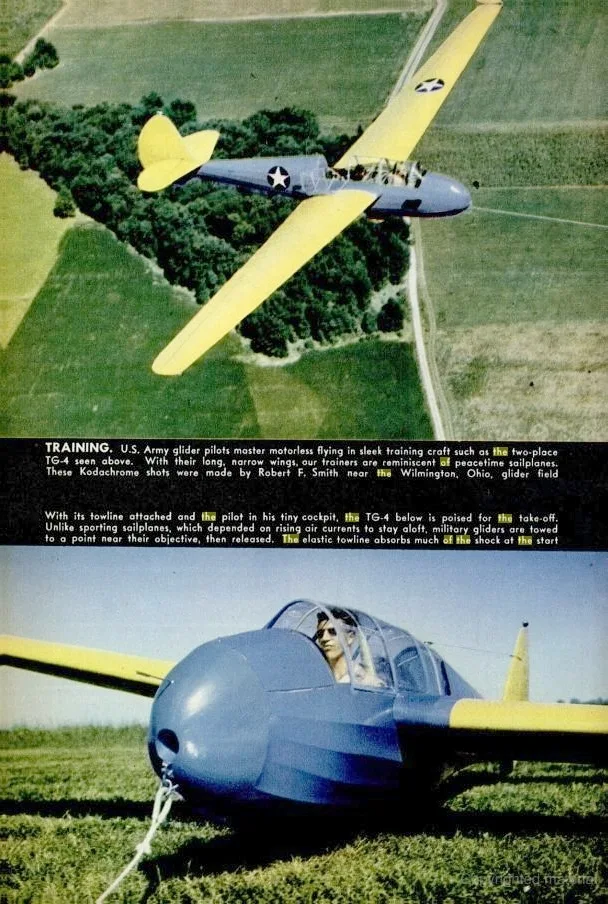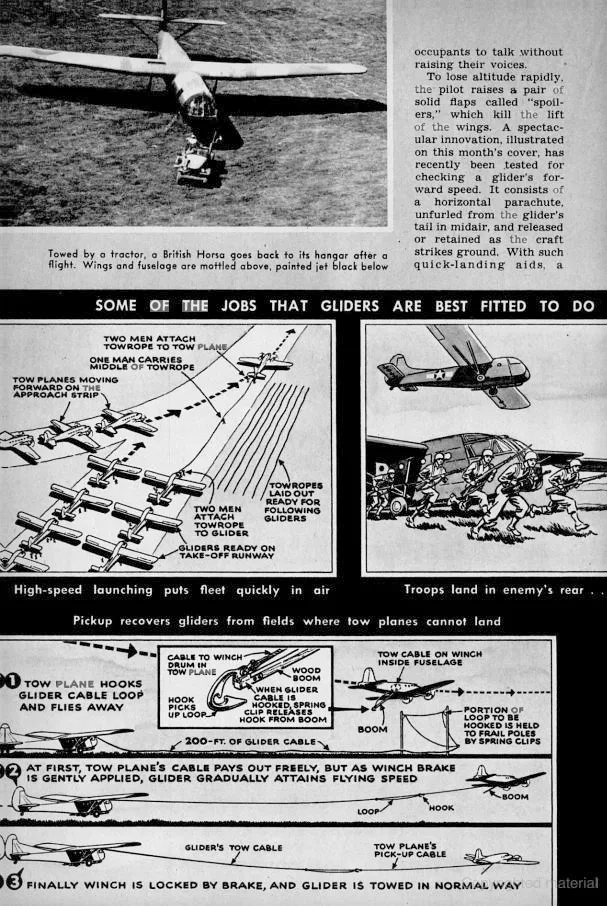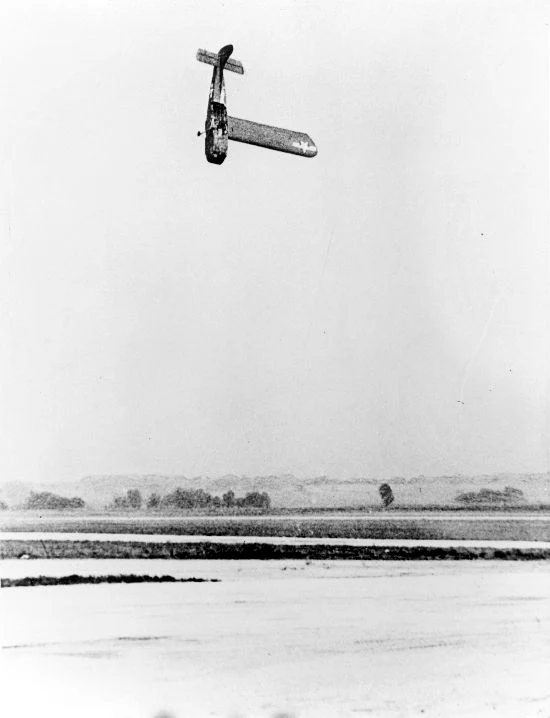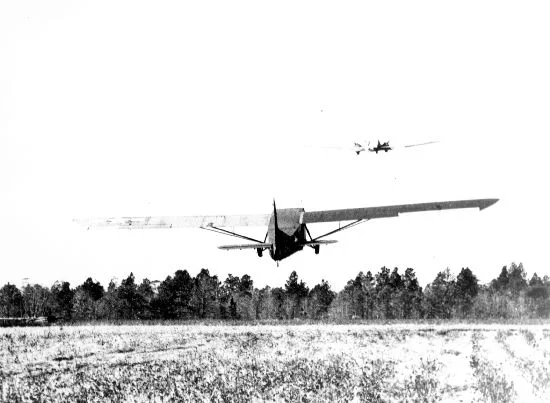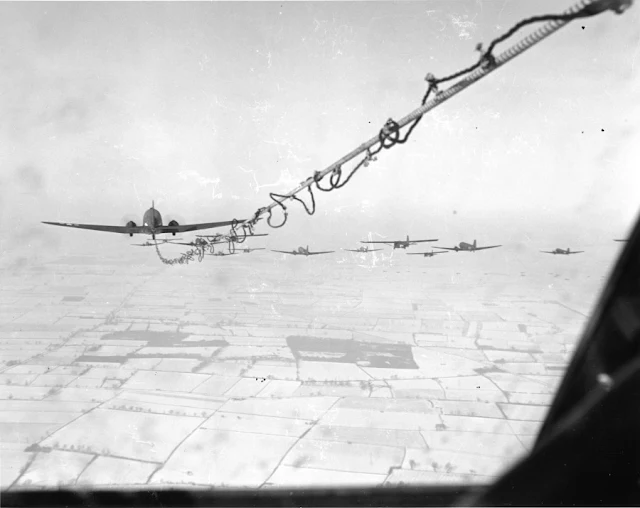 |
The Waco CG-4 was the most widely used American troop/cargo military glider of World War II. It was designated the CG-4A by the United States Army Air Forces, and given the service name Hadrian (after the Roman emperor) by the British.
The glider was designed by the Waco Aircraft Company. Flight testing began in May 1942. More than 13,900 CG-4As were eventually delivered.
Design and Development
The CG-4A was constructed of fabric-covered wood and metal and was crewed by a pilot and copilot. It had two fixed mainwheels and a tailwheel.
The CG-4A could carry 13 troops and their equipment. Cargo loads could be a 1⁄4-ton truck (i.e. a Jeep), a 75 mm howitzer, or a 1⁄4-ton trailer, loaded through the upward-hinged nose section. Douglas C-47 Skytrains were usually used as tow aircraft. A few Curtiss C-46 Commando tugs were used during and after the Operation Plunder crossing of the Rhine in March 1945.
The USAAF CG-4A tow line was 11⁄16 inch (17 mm) nylon, 350 feet (110 m) long. The CG-4A pickup line was 15⁄16 inch (24 mm) diameter nylon, but only 225 ft (69 m) long including the doubled loop.
In an effort to identify areas where strategic materials could be reduced, a single XCG-4B was built at the Timm Aircraft Corporation using wood for the main structure.
Production
From 1942 to 1945, the Ford Motor Company's "Iron Mountain" plant in Kingsford, Michigan, built 4,190 CG-4A gliders (more than any other company in the nation) at a lower per-unit cost than any other manufacturer.
The 16 companies that were prime contractors for manufacturing the CG-4A were:
Babcock Aircraft Company of DeLand, Florida (60 units at $51,000 each)
Cessna Aircraft Company of Wichita, Kansas (750 units); the entire order was actually subcontracted to Boeing Aircraft Company's new Wichita plant.
Commonwealth Aircraft of Kansas City, Kansas (1,470 units)
Ford Motor Company of Kingsford, Michigan (4,190 units at $14,891 each)
G&A Aircraft of Willow Grove, Pennsylvania (627 units)
General Aircraft Corporation of Astoria, Queens, New York) (1,112 units)
Gibson Refrigerator of Greenville, Michigan (1,078 units)
Laister-Kauffman Corporation of St. Louis, Missouri (310 units)
National Aircraft Corporation of Elwood, Indiana (one unit, at an astronomical $1,741,809)
Northwestern Aeronautical Corporation of Minneapolis, Minnesota (1,510 units)
Pratt-Read of Deep River, Connecticut (956 units)
Ridgefield Manufacturing Company of Ridgefield, New Jersey (156 units)
Robertson Aircraft Corporation of St. Louis, Missouri (170 units)
Timm Aircraft Company of Van Nuys, California (434 units)
Waco Aircraft Company of Troy, Ohio (1,074 [999] units at $19,367 each)
Ward Furniture Company of Fort Smith, Arkansas (7 units)
The factories ran 24-hour shifts to build the gliders. One night-shift worker in the Wicks Aircraft Company factory in Kansas City wrote,
On one side of the huge bricked-in room is a fan running, on the other a cascade of water to keep the air from becoming too saturated with paint. The men man the paint sprayers covering the huge wings of the glider with the Khaki or Blue and finishing it off with that thrilling white star enclosed in a blue circle that is winging its way around the world for victory ... The wings are first covered with a canvas fabric stretched on like wallpaper over plywood then every seam, hold, open place, closed place, and edge is taped down with the all adhesive dope that not only makes the wings airtight, but covers my hands, my slacks, my eyebrows, my hair, and my tools with a fast-drying coat that peels off like nail polish or rubs off with a thinner that burns like Hell.
Type: Military glider
Manufacturer: Waco Aircraft Company
Built by:
Cessna
Ford
Gibson Appliance
Primary users:
United States Army Air Forces
Royal Air Force
Royal Canadian Air Force
United States Navy
Number built: 13,909
First flight: 1942
Variants: Waco CG-15
Operational History
Sedalia Glider Base was originally activated on 6 August 1942. In November 1942 the installation became Sedalia Army Air Field, (after the war would be renamed Whiteman Air Force Base) and was assigned to the 12th Troop Carrier Command of the United States Army Air Forces. The field served as a training site for glider pilots and paratroopers. Assigned aircraft included the CG-4A glider, Curtiss C-46 Commando, and Douglas C-47 Skytrain. The C-46 was not used as a glider tug in combat, however, until Operation Plunder (the crossing of the Rhine) in March 1945.
CG-4As went into operation in July 1943 during the Allied invasion of Sicily. They were flown 450 miles across the Mediterranean from North Africa for the night-time assaults such as Operation Ladbroke. Inexperience and poor conditions contributed to the heavy losses. They participated in the American airborne landings in Normandy on 6 June 1944, and in other important airborne operations in Europe and in the China Burma India Theater. Although not the intention of the Army Air Forces, gliders were generally considered expendable by high-ranking European theater officers and combat personnel and were abandoned or destroyed after landing. While equipment and methods for extracting flyable gliders were developed and delivered to Europe, half of that equipment was rendered unavailable by certain higher-ranked officers. Despite this lack of support for the recovery system, several gliders were recovered from Normandy and even more from Operation Market Garden in the Netherlands and Wesel, Germany.
The CG-4A found favor where its small size was a benefit. The larger British Airspeed Horsa could carry more troopers (seating for 28 or a jeep or an anti-tank gun), and the British General Aircraft Hamilcar could carry 7 tons (enough for a light tank), but the CG-4A could land in smaller spaces. In addition, by using a fairly simple grapple system, an in-flight C-47 equipped with a tail hook and rope braking drum could "pick up" a CG-4A waiting on the ground. The system was used in the 1945 high-elevation rescue of the survivors of the Gremlin Special 1945 crash, in a mountain valley of New Guinea.
The CG-4A was also used to send supplies to partisans in Yugoslavia.
After World War II ended, most of the remaining CG-4As were declared surplus and almost all were sold. Many were bought for the wood in the large shipping boxes. Others were bought for conversion to towed camping homes with the wing and tail end cut off and being towed by the rear section and others sold for hunting cabins and lake side vacation cabins.
The last known use of the CG-4A was in the early 1950s by the USAF with an Arctic detachment aiding scientific research. The CG-4As were used for getting personnel down to, and up from, floating ice floes, with the glider being towed out, released for landing, and then picked up later by the same type of aircraft, using the hook and line method developed during World War II. The only modification to the CG-4A was the fitting of wide skis in place of the landing gear for landing on the Arctic ice floes.
Variants
XCG-4: Prototypes, two built, plus one stress test article
CG-4A: Main production variant, survivors became G-4A in 1948, 13,903 built by 16 contractors
XCG-4B: One Timm-built CG-4A with a plywood structure
XPG-1: One CG-4A converted with two Franklin 6AC-298-N3 engines by Northwestern
XPG-2: One CG-4A converted with two 175 hp (130 kW) Ranger L-440-1 engines by Ridgefield
XPG-2A: Two articles: XPG-2 engines changed to 200 hp (150 kW) plus one CG-4A converted also with 200 hp (150 kW) engines
PG-2A: Production PG-2A with two 200 hp (150 kW) L-440-7s, redesignated G-2A in 1948, 10 built by Northwestern
XPG-2B: Cancelled variant with two R-775-9 engines
LRW-1: CG-4A transferred to the United States Navy (13 units)
G-2A: PG-2A re-designated in 1948
G-4A: CG-4A re-designated in 1948
G-4C: G-4A with different tow-bar, 35 conversions
Hadrian Mk.I: Royal Air Force designation for the CG-4A, 25 delivered
Hadrian Mk.II: Royal Air Force designation for the CG-4A with equipment changes
Operators
Canada: Royal Canadian Air Force
Czechoslovakia: Czechoslovak Air Force operated 2 Wacos, designated NK-4
United Kingdom:
Army Air Corps
Glider Pilot Regiment
Royal Air Force
No. 668 Squadron RAF
No. 669 Squadron RAF
No. 670 Squadron RAF
No. 671 Squadron RAF
No. 672 Squadron RAF
No. 673 Squadron RAF
United States:
United States Army Air Forces
United States Navy
Accidents and Incidents
1 August 1943: CG-4A-RO 42-78839, built by contractor Robertson Aircraft Corporation, lost its right wing and plummeted to earth immediately after release by a tow airplane over Lambert Field, St. Louis, Missouri, USA. Several thousand spectators had gathered for the first public demonstration of the St. Louis-built glider, which was flown by 2 USAAF crewmen and carried St. Louis mayor William D. Becker, Robertson Aircraft co-founder Maj. William B. Robertson, and 6 other VIP passengers; all 10 occupants perished in the crash. The accident was attributed to the failure of a defective wing strut fitting that had been provided by a subcontractor; the post-crash investigation indicted Robertson Aircraft for lax quality control; several inspectors were relieved of duty.
Surviving Aircraft
42-43809 – On display at the Museum of Army Flying in Middle Wallop, Hampshire.
45-13696 – CG-4A under restoration at the Yanks Air Museum in Chino, California.
45-14647 – Cockpit section on static display at the Pima Air & Space Museum in Tucson, Arizona.
45-15009 – CG-4A on static display at the Air Mobility Command Museum at Dover Air Force Base near Dover, Delaware.
45-15574 – On static display at the Cradle of Aviation Museum in Garden City, New York.
45-15691 – On display at the Silent Wings Museum in Lubbock, Texas.
45-15965 – On display at the Kalamazoo Air Zoo in Portage, Michigan. It is painted as 42–46574.
45-17241 – On static display at the Airborne Museum in Sainte-Mère-Église, Normandy.
45-27948 – CG-4A on static display at the National Museum of the United States Air Force in Dayton, Ohio.
Replica – On display at the Fagen Fighters WWII Museum in Granite Falls, Minnesota.
Replica – On display at The Fighting Falcon Museum in Greenville, Michigan.
Unknown – On display at the Menominee Range Historical Foundation in Iron Mountain, Michigan.
Unknown – CG-4A on display at the National Soaring Museum in Elmira, New York.
Unknown – Cockpit section on display at the Travis Air Force Base Heritage Center in Fairfield, California.
CG-4A on display at the Silent Wings Museum in Lubbock, Texas.
Unknown – CG-4A on display at the Don F. Pratt Memorial Museum at Fort Campbell near Clarksville, Tennessee.
Unknown – CG-4A on static display at the Yorkshire Air Museum in Elvington, Yorkshire.
Unknown – On display at the Assault Glider Trust in Shawbury, Shropshire.
Unknown – On static display at the Airborne & Special Operations Museum in Fayetteville, North Carolina.
Unknown – On static display during restoration at the U.S. Veterans Memorial Museum in Huntsville, Alabama.
Replica - A CG-4 'Hadrian' nose section is on display at the South Yorkshire Aircraft Museum, Doncaster, United Kingdom. The replica was produced for the film Saving Private Ryan.
Specifications (CG-4A)
Crew: two pilots
Capacity: 13 troops, or quarter-ton truck (Jeep) and 4 troopers, or 6 litters and 4,197 pounds (1,904 kg) useful load
Length: 48 ft 8 in (14.8 m)
Wingspan: 83 ft 8 in (25.5 m)
Height: 15 ft 4 in (4.7 m)
Wing area: 900 sq ft (83.6 m2)
Empty weight: 3,900 lb (1,769 kg)
Gross weight: 7,500 lb (3,402 kg)
Maximum takeoff weight: 7,500 lb (3,402 kg)
Maximum take off (Emergency Load): 9,000 pounds (4,100 kg)
Maximum speed:
150 mph (240 km/h, 130 kn) CAS] at 7,500 pounds (3,400 kg)
128 mph (206 km/h) CAS/135 mph (217 km/h) IAS at 9,000 pounds (4,100 kg)
Cruise speed: 73 mph (117 km/h, 63 kn) IAS
Stall speed: 49 mph (79 km/h, 43 kn) with design load 7,500 pounds (3,400 kg)
Never exceed speed: 150 mph (241 km/h, 130 kn) IAS
Maximum glide ratio: 12:1
Wing loading: 8.33 lb/sq ft (40.7 kg/m2)
Rate of sink: About 400 ft/min (2 m/s) at tactical glide speed (IAS 60 mph; 97 km/h)
Landing run: 600–800 feet (180–240 m) for normal three-point landing; "Landing rolls of approximately 2,000 to 3,000 feet (610 to 910 m) are to be expected at the higher emergency gross weights..."
Bibliography
AAF Manual No. 50-17, Pilot Training Manual for the CG-4A Glider. US Government, 1945.
AAF TO NO. 09-40CA-1, Pilot's Flight Operating Instructions for Army Model CG-4A Glider, British Model Hadrian. US Government, 1944.
Andrade, John M. U.S. Military Aircraft Designations and Serials since 1909. Earl Shilton, Leister, UK: Midland Counties Publications, 1979.
Diehl, Alan E., PhD. Silent Knights: Blowing the Whistle on Military Accidents and Their Cover-ups. Dulles, Virginia: Brassey's, Inc., 2002.
Fitzsimons, Bernard, ed. "Waco CG-4A." Illustrated Encyclopedia of 20th Century Weapons and Warfare, Volume 11. London: Phoebus, 1978.
Gero, David B. Military Aviation Disasters: Significant Losses Since 1908. Sparkford, Yoevil, Somerset, UK: Haynes Publishing, 2010.
Masters, Charles J., Glidermen of Neptune: The American D-Day Glider Attack Carbondale, Illinois: Southern Illinois University Press, 1995.
Soukup, Oldřich (1979). "Kluzáky Československého Vojenského Letectva (I.)" [Czechoslavak Military Gliders (I.)]. Letectví a Kosmonautika (in Czech). Vol. 55, no. 18. pp. 693–695.
 |
| German troops examine an abandoned Waco, Normandy, June 1944. (Bundesarchiv Bild 146-2004-0176) |
 |
| Waco XPG-1 powered glider prototype. (U.S. Army Air Forces) |
 |
| Waco XPG-2 powered glider. (U.S. Army Air Forces) |
 |
| Waco PG-2A. (Erection and Maintenance Instructions for Model PG-2A Glider, AN 09-75DA-2, 1946, 2. Provided by the National Museum of the United States Air Force, Dayton, Ohio.) |
 |
| A British Hadrian. |
 |
| Cockpit of a CG-4A at the Silent Wings Museum, 2008. |
 |
| Waco CG-4A. |
 |
| A U.S. Army Air Force Waco CG-4A glider. (USAAF) |
 |
| C-47 of 62d Troop Carrier Squadron, the 314th Troop Carrier Group, and Waco gliders, at RAF Saltby, England. 1944. (USAAF) |
 |
| CG-4a Waco Glider of the 315th Troop Carrier Group - RAF Aldermaston, 1943. (USAAF) |
 |
| Members of the 504th Parachute Infantry Regiment prepare a weapon for stowage aboard a glider. April 1943. (US Army) |
 |
| CG4A Glider, 61st Troop Carrier Group. (USAAF) |
1235.jpg) |
| Hadrian Mark I, probably FR557, under tow at the Airborne Forces Experimental Establishment, Sherburn-in-Elmet, Yorkshire. (Imperial War Museum E(MOS)1235) |
 |
| CG-4A Waco Gliders landing at the unfinished Beuzeville Airfield (A-6), France, 1944. (USAAF) |
 |
| C-47s with CG-4 Waco Gliders just before D-Day, 1944, 316th Troop Carrier Group, 37th TCS. (United States Army Air Force from National Archives) |
 |
| CG-4A on display at the Silent Wings Museum. 22 Nov 2022. (Sclemmons) |
 |
| CG-4a Gliders of the 442d Troop Carrier Group at Chilbolton airfield just before Operation Market Garden. Sep 1944. (USAAF) |
 |
| Cockpit of a WWII Waco CG-4 attack glider from the collection of the Fagen Fighters WWII Museum in Granite Falls, Minnesota. 10 Nov 2018. (Aaron Headly) |
 |
| Invasion drawing by Captain Creekmore from D-day invasion of France. (Raymond Creekmore) |
 |
| C-47 and CG-4 Glider, Dalhart Army Airfield. 1943. (USAAF) |
.jpg) |
| Glider troops after landing near Wesel, Germany, 24 March 1945. (US Army) |
 |
| THE CAMPAIGN IN SICILY 1943. Planning and Preparations January - July 1943: A jeep is loaded onto an American Waco CG-4A glider. July 1943. Imperial War Museum CNA1662) |
 |
| Airborne troops exiting CG-4 glider, Laurinburg-Maxton Army Air Base, 1942. (USAAF) |
 |
| C-47s towing CG-4A gliders, Laurinburg-Maxton Army Air Base, 1942. (USAAF) |
 |
| Laurinburg-Maxton Army Air Base, CG-4A glider landing, 1942. (USAAF) |
 |
| Laurinburg-Maxton Army Air Base, CG-4A glider ready for snatch pickup by a C-47, 1942. (USAAF) |
 |
| Laurinburg-Maxton Army Air Base CG-4A glider taking off after snatch pickup, 1942. (USAAF) |
 |
| Laurinburg-Maxton Army Air Base, Jeep coming out of front cargo door, 1942. (USAAF) |
 |
| Laurinburg-Maxton Army Air Base, Jeep coming out of front cargo door, 1942. (USAAF) |
 |
| Laurinburg-Maxton Army Air Base, unloading artillery from CG-4A glider, 1942. (USAAF) |
 |
| Laurinburg-Maxton Army Air Base, unloading tractor from CG-4A glider, 1942. (USAAF) |
 |
| Douglas C-47s and CG-4A Waco Gliders, of the 436th Troop Carrier Group, lined up on the runway at Membury Airfield, England. (USAAF) |
.jpg) |
| Army engineers prepare to haul a glider off the Myitkyina airfield. 17 May 1944. (Signal Corps SC 190519) |
.jpg) |
| Just before the take-off for Holland, where they landed Sunday afternoon, 17 September, 1944, these gliders are lined up at an airport somewhere in England. (Signal Corps SC 195697) |
.jpg) |
| Lined up with hatches open to receive their cargo, these gliders are part of the 82nd Airborne Div, which invaded Holland from Cottesmore Airdrome, England. 17 September 1944. (Signal Corps SC 195699) |
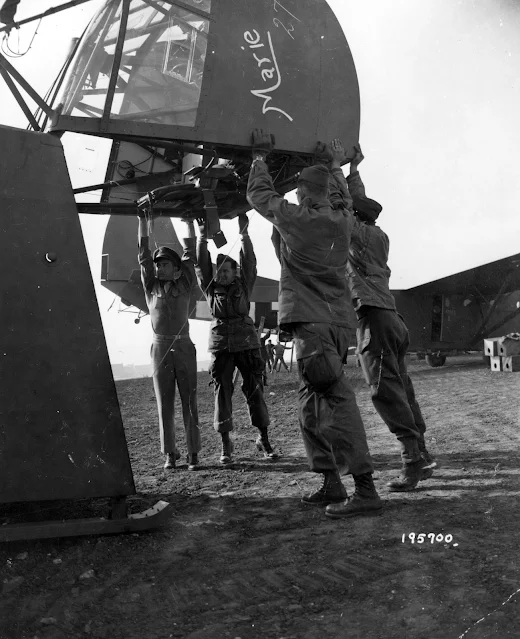.jpg) |
| Yanks of an airborne unit close the cargo loading hatch of a glider preparatory to the takeoff from England for the invasion of Holland. 17 September 1944. (Signal Corps SC 195700) |
.jpg) |
| Seated in the shade cast by the tail of a glider, two French women chat with U. S. Army MPs as they await questioning by an Army officer. June 19, 1944.. (Signal Corps) |
 |
| The Waco Hadrian glider 'Voo-Doo' the first Hadrian glider to be towed across the Atlantic being unloaded at Prestwick, 28 June 1943. (Imperial War Museum TR1159) |
 |
| Waco CG-4A glider at Twenty-nine Palms Air Academy, 1942. (US Army) |
.jpeg) |
| Original caption: "Troops of a glider field artillery battalion enter their glider in smart, snappy style, ready to take off for invasion maneuvers." (U.S. Army Signal Corps) |
.jpg) |
| View of the front of the same CG-4A glider as in the above photo. (Alan Wilson) |
 |
| Waco CG-4A. |
 |
| C-47 takes off towing a Waco CG-4A glider. |
 |
| Pilot and co-pilot in the cockpit of a Waco C G-4A glider. |
 |
| A Waco CG-4A glider flips on its nose while landing during Operation Dragoon, the invasion of southern France. |
 |
| A Waco CG-4A glider flown by the 1st Air Commando, is being used by OSS Detachment 101 in Burma in 1944. |
 |
| Waco CG-4A in flight. |
 |
| Waco CG-4A gliders lining up on an airstrip in Sicily, Italy, August 1943. |
 |
| C-47 Skytrain aircraft towing two CG-4A gliders during a training exercise. |
 |
| View from cockpit of a CG-4A glider as it was towed by a C-47 Skytrain aircraft, 1944 |
 |
| A CG-4A cargo glider of the 439th Troop Carrier Group takes off from air base A-39 Châteaudun, France. 27 December 1944. |
 |
| Service Command mechanics attach a wing to one of the gliders at Crookham Common, England. |
 |
| CG-4A glider assembly yard. |
 |
| CG-4A gliders in a glider assembly yard. |
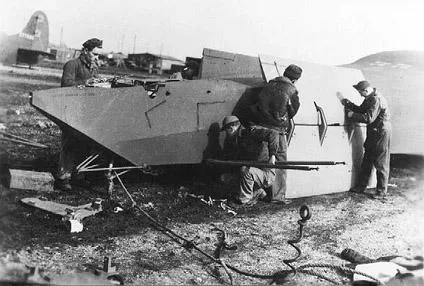 |
| Preparing CG-4A wings for attachment to the fuselage. |
 |
| Glider mechanic working on a CG-4A glider interior at a glider assembly yard. |
 |
| Assembling the tail of a CG-4A glider at a glider assembly yard. |
 |
| Attaching the tail units to a CG-4A glider at a glider assembly yard. |
 |
| The cockpit of a CG-4A glider. |
 |
| CG-4A fuselages ready for wings and tail units at a glider assembly yard. |
 |
| CG-4A gliders assembled at a glider assembly yard and ready for service. |
 |
| CG-4A glider fuselage being readied at a glider assembly yard. |
 |
| Attaching the main wheels to the fuselage of a CG-4A glider at a glider assembly yard. |
 |
| A C-47 tows two CG-4A gliders to their new home after being assembled at a glider assembly yard. |
 |
| Dozens of CG-4A gliders, ready for service, awaiting tows to their new home with a glider unit. |
 |
| Two CG-4A gliders ready to be towed by a C-47 to their new home with a glider unit after being assembled at a glider assembly yard. |
 |
| CG-4A Glider above Columbus, Indiana, 1945. |
 |
| Pilot at the controls of a CG-4A glider. |
 |
| Co-pilot of the same CG-4A glider as in the previous photo. |
 |
| View from the cockpit of a CG-4A glider under tow by a C-47. 1943. |
 |
| Used effectively in Burma. After unloading equipment loaded up with stretcher and walking wounded and then snatched out. Returned to Hospital in about two hours as opposed to two months by ambulance. |
 |
| C-47 about to “snatch” a fully-loaded CG-4A glider. |
 |
| Glider tow release mechanism. |
 |
| Waco CG-4A glider in flight. |
 |
| C-47 tow planes and Waco CG-4A gliders over the mountains of Burma. |
 |
| Looking towards the cockpit inside a CG-4A glider. |
 |
| “General George,” CG-4A being unloaded, 1st Air Commando Group. |
 |
| A jeep exits a CG-4A glider. |
 |
| Loading a jeep into a CG-4A glider by lifting the hinged pilot’s compartment. |
 |
| Landing at night in the pitch-black Burmese jungle caused these two CG-4A gliders to crash into each other. Many were killed in the landings on the first night. |
 |
| CG-4A and Horsa gliders littering Normandy fields amongst the hedgerows, France. June 1944. |
 |
| Glider pilot Charlie Rex (on right) and the Glider Engineering section of the 315th Troop Carrier Group posing in front of CG-4A glider “Hiya Honey.” 1943. |
 |
| CG-4A glider packing cases in a glider assembly yard. |
 |
| Atterbury Army Air Field. A C-47 is taking off but not yet airborne, while the CG-4A glider it is towing is already in the air, 1945. |
 |
| USAAF metal Glider Pilot Wings. |
 |
| Glider Infantry Badge. |
 |
| USAAF cloth glider pilot wings. |
 |
| USAAF Troop Carrier Command demonstrating loading wounded men onto a CG-4A glider, Roosevelt Field, Long Island, New York. 24 Mar 1945. Note Dodge WC54 ambulance. |
 |
| CG-4A Waco glider of the 315th Troop Carrier Group, RAF Aldermaston, 1943. |
 |
| C-47 of the 62nd Troop Carrier Squadron, 314th Troop Carrier Group, and Waco CG-4A gliders, at RAF Saltby, England. |
 |
| C-47 Skytrain aircraft towing CG-4A glider off an Algerian airstrip. 1943. |
 |
| A line of Waco CG-4A gliders. |
 |
| Waco CG-4A glider in flight. |
 |
| CG-4A gliders of the 313th Troop Carrier Group after landing during the Market Garden operation, Holland. 23 September 1944. |
 |
| Still from movie footage of a CG-4A glider landing at Son, Holland. Operation Market Garden. September 1944. |
 |
| Ford-built CG-4A glider sitting in a pasture, Normandy, France. June 1944. |
 |
| C-47 Skytrain aircraft of 315th Troop Carrier Group dropping 41 sticks of 1st Polish Airborne Brigade into Graves, Netherlands. 23 September 1944. Note CG-4A gliders already on the ground. |
 |
| Cletrac tractor pulling a CG-4A fuselage out of its packing case at a glider assembly yard. |
 |
| Working on the fuselage of a CG-4A glider at a glider assembly yard. |
 |
| Waco CG-4A glider cockpit interior. |
 |
| CG-4A glider coming in to land with spoilers on. |
 |
| CG-4A glider on long tow as seen from another glider. |
 |
| C-47 with a double tow of CG-4A gliders out of Atterbury Army Air Field. |
 |
| A double tow line up of CG-4A gliders on the field at Atterbury Army Air Field. |
 |
| Waco CG-4A glider of the 9th Troop Carrier Command comes in for a landing at Remagen, Germany, to pick up wounded personnel. 21 May 1945. |
 |
| U.S. Army Air Forces Waco CG-4A glider with Lt. Suella Bernard in the right-hand seat of the cockpit just as the glider is being snatched by a C-47. |
 |
| Glider pick-up ground station unit. |
 |
| Glider pick-up unit installed in a Douglas C-47. |
 |
| Waco CG-4A glider pickup by Douglas C-47. |
 |
| The snatch is made! |
 |
| A CG-4A glider of the Ninth Troop Carrier Command loaded with injured soldiers, takes off from a field at Remagen, Germany. 22 March 1945. |
 |
| CG-4A taking off after snatch pickup, Laurinburg-Maxton Army Air Base. 1942. |
 |
| A CG-4A glider and C-47 tow plane will deliver its wounded in a matter of minutes rather than the usual days by truck. |
 |
| CG-4A glider production in Kingsford’s Ford Motor Company Plant. |
 |
| CG-4A glider on exhibit at the Ford Motor Company Plant in Kingsford for the Army-Navy “E” Award, presented on 24 June 1944. |
 |
| Curious Dutch civilians check out a CG-4A glider after landing, Operation Market Garden. September 1944. |
 |
| Unloading a 57mm anti-tank gun from a CG-4A glider. |
 |
| Loading a trailer into a CG-4A glider. |
 |
| CG-4A glider with Troop Carrier Command insignia on nose. |
 |
| CG-4A in aluminum doped finish with Troop Carrier Command insignia on nose. |
 |
| Inside view of the front fuselage of a Waco CG-4 glider. |
 |
| Inside view of the rear fuselage of a Waco CG-4 glider. |
 |
| Waco CG-4A glider. |
 |
| Waco CG-4A. |
.jpg) |
| Waco CG-4A. |
 |
| Waco CG-4A component breakdown. |
 |
| Waco CG-4A cockpit and instrument panel. |
 |
| Waco CG-4A useful load installation. |
 |
| Waco CG-4A modification and reinforcement of windshield. |
 |
| Waco CG-4A pre-flight inspection manual. |
 |
| Waco CG-4A pre-flight inspection manual page. |
 |
| Waco CG-4A pre-flight inspection manual page. |
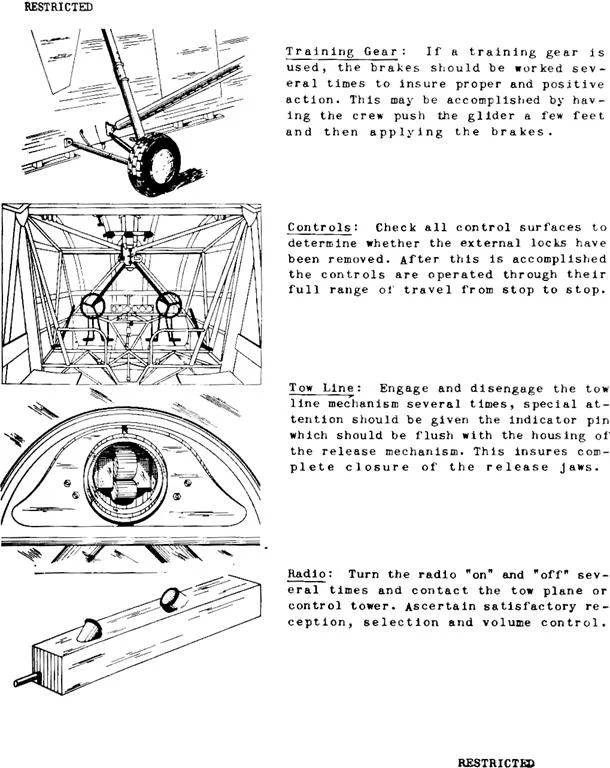 |
| Waco CG-4A pre-flight inspection manual page. |
 |
| Waco CG-4A pre-flight inspection manual page. |
 |
| Waco CG-4A interphone. |
 |
| U.S. glider pilots who ferried assault paratroopers to their D-Day destinations in Normandy are picked up at the beachhead for return to England. |
 |
| M1 75mm Pack Howitzer being loaded into a Waco CG-4A glider during training in the U.S. |
 |
| Lockheed C-60 Lodestars towing Waco CG-4A gliders over Texas. |
 |
| Waco CG-4A glider being crated for shipment. |
 |
| Waco CG-4A glider being crated for shipment. |
 |
| Waco CG-4A glider being crated for shipment. |
 |
| Waco CG-4A glider in Pittsburgh during World War II. Heinz employees supplied the wings. |
 |
| Waco CG-4A glider being crated for shipment. |
 |
| Waco CG-4A glider being crated for shipment. |
 |
| Waco CG-4A glider being crated for shipment. |
 |
| Waco CG-4A glider being crated for shipment. |
 |
| CG-4A Troop Glider being recovered at Wesel, Germany, 1 April 1945. |
 |
| Waco CG-4A taking off. |
 |
| Refueling C-47 "Mary Lou". |
 |
| Attaching tow rope to C-47. |
 |
| 82nd Airborne Division loading Jeeps into Waco CG-4A gliders. The box in the left Jeep is a SCR-625-C mine detector and a paratrooper bicycle is in the right Jeep, September 1944. |
 |
| Kairouan aerial view. Note tents and glider dispersal, landing field upper left. |
 |
| Waco CG-4A setup for transport of wounded on litters. The glider would be loaded and "snatched" by a C-47. |
 |
| Note the non-standard national marking on the fuselage. The bars were added when the marking was changed and changes were hastily made and sometimes not to official specifications. |






.jpg)
.jpg)
.jpg)






.jpg)


,_in_1943_(342-FH-3A27180-A67255AC).jpg)



.jpg)
_-_50546988838.jpg)


